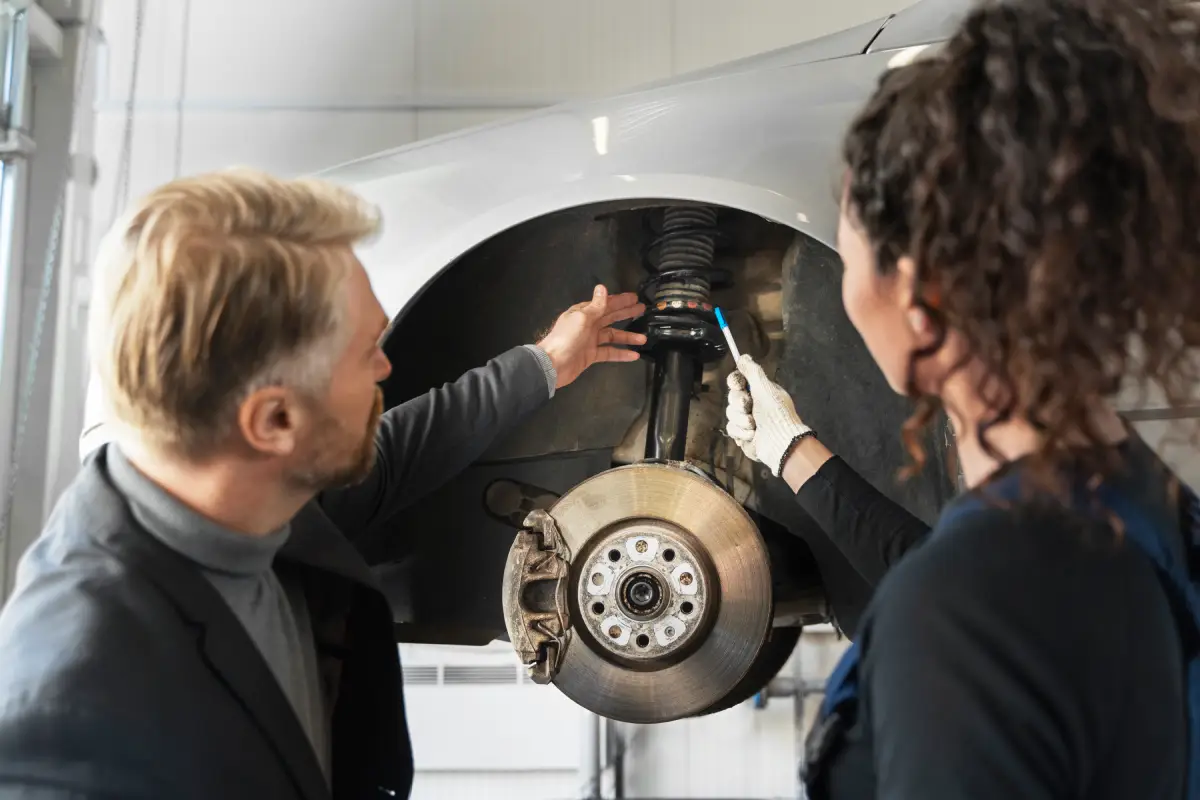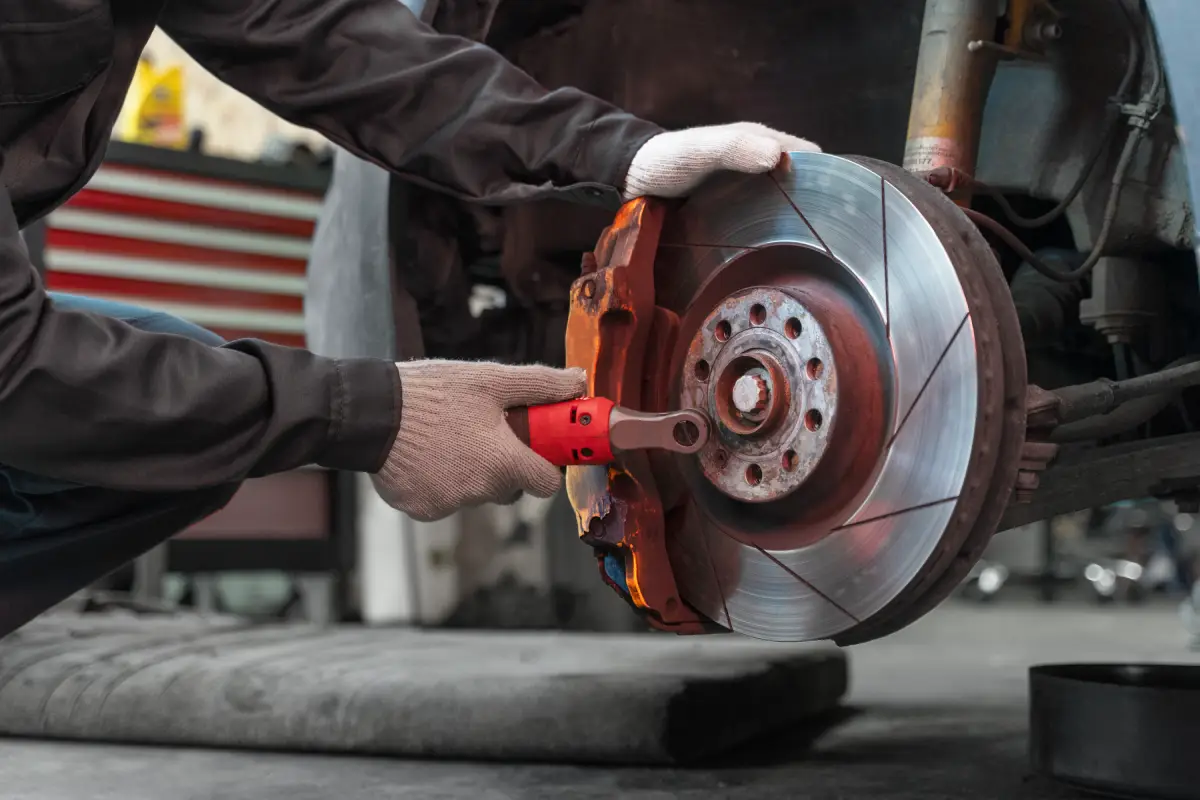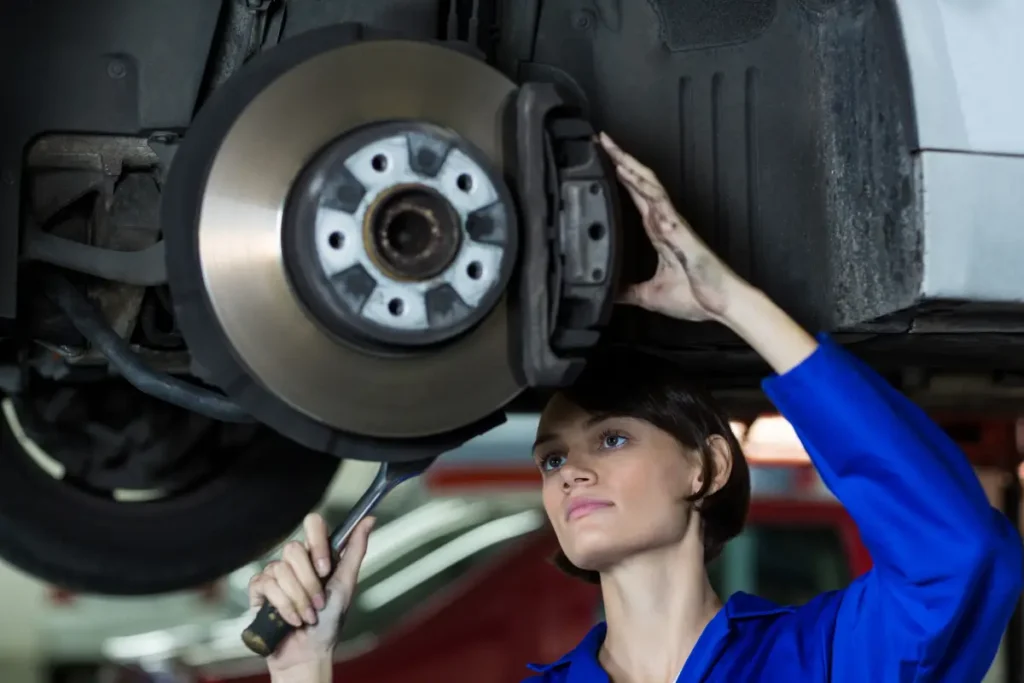Welcome to your guide on anti lock braking system abs! This technology saves thousands of lives every year. We’ll explain how it works, why it matters, and what you need to know as a driver.
An anti lock braking system abs stops your wheels from locking up when you brake hard. This keeps you in control during emergencies. It’s one of the most important safety features in modern cars.
Let’s explore why this braking technology changed driving forever.
What Is an Anti-Lock Braking System?
An anti lock braking system abs is a car safety feature that helps you stop safely. When you slam on the brakes, this system prevents your wheels from skidding.
Here’s the simple idea: locked wheels can’t steer. If your wheels lock up during hard braking, you lose control. Your car just slides in one direction. The anti lock braking system abs fixes this problem.
The system uses sensors and computer controls to pump the brakes for you. It does this much faster than any human could. We’re talking 15 times per second or more!

The Basic Parts
Every anti lock braking system abs has four main parts:
Wheel Speed Sensors: These watch how fast each wheel spins. They sit near each wheel and send constant updates to the computer.
ABS Control Module: This computer brain receives data from the sensors. It decides when to activate the system.
Hydraulic Control Unit: This part controls the brake pressure. It can increase, decrease, or hold pressure on each wheel independently.
Valves: These open and close to control brake fluid flow. Each wheel has its own valve.
These components work together in milliseconds. The speed is what makes the vehicle safety system so effective.
How Does ABS Work Step by Step?
Understanding how your anti lock braking system abs works helps you use it properly. Let’s break down the process:
Step 1: Normal Braking
During normal driving, the ABS monitoring system stays quiet. It just watches the wheel speeds. Everything works like regular brakes.
Step 2: Hard Braking Detected
When you stomp on the brake pedal, sensors notice one or more wheels slowing down too fast. This means a wheel is about to lock up.
Step 3: System Activation
The ABS control module jumps into action. It tells the hydraulic unit to reduce pressure on that wheel. This happens in a fraction of a second.
Step 4: Pressure Modulation
The system rapidly releases and reapplies brake pressure. This is called pressure modulation. It happens so fast you’ll feel a pulsing sensation in the brake pedal.
Step 5: Traction Maintained
By pulsing the brakes, the anti lock braking system abs keeps the wheels rolling slightly. Rolling wheels grip better than locked wheels. You can still steer.
Step 6: Normal Operation Resumes
Once the emergency passes and you ease off the brake, the system returns to normal mode. Everything resets for the next time.
This entire cycle repeats multiple times per second during hard braking. It’s like having a professional race car driver pumping your brakes perfectly.

Real Benefits of ABS in Your Car
Why does every new car come with an anti lock braking system abs? The benefits are clear and proven:
Shorter Stopping Distances
On most road surfaces, ABS helps you stop faster. Studies show stopping distance improvements of 10-20% on wet roads. The National Highway Traffic Safety Administration (NHTSA) reports that ABS reduces fatal crashes by up to 18%.
Better Steering Control
This is the biggest advantage. With the anti lock braking system abs, you can steer around dangers while braking hard. Without it, locked wheels mean no steering. Your car just goes straight.
Fewer Accidents
Real-world crash data proves ABS works. According to 2024 NHTSA statistics, vehicles with ABS have 35% fewer accidents in wet conditions compared to non-ABS vehicles. The Insurance Institute for Highway Safety (IIHS) found that ABS reduces the risk of fatal multi-vehicle crashes by 18%.
Works on All Surfaces
Modern anti lock braking system abs adapts to different roads. It works on:
- Wet pavement
- Gravel roads
- Snowy conditions
- Ice (though stopping distances increase)
- Dry roads
Prevents Tire Damage
Locked wheels create flat spots on tires. This damages them permanently. The brake assist system prevents this expensive problem.
Reduces Driver Panic
Knowing your car has ABS gives confidence. You can brake hard without fear of losing control. This psychological benefit matters in emergencies.
Works With Other Safety Systems
The anti lock braking system abs teams up with:
- Electronic stability control
- Traction control systems
- Brake assist
- Emergency brake assist
These vehicle safety systems share sensors and work together to keep you safe.
The History of ABS Technology
The lock braking system abs has an interesting past:
Early Concepts (1920s-1950s)
The idea started with aircraft. Planes needed to stop on wet runways without skidding. Engineers developed early anti-skid systems for landing gear.
First Car Systems (1960s-1970s)
In 1966, Jensen FF became the first production car with a basic ABS. But the technology was expensive and unreliable.
Bosch changed everything in 1978. They created the first electronic ABS that actually worked well. It appeared in Mercedes-Benz and BMW cars.
Mass Adoption (1980s-1990s)
Through the 1980s, more car makers added the anti lock braking system abs. At first, it was a luxury option. By the mid-1990s, it became standard on most new cars.
Modern Era (2000s-Present)
Today’s braking technology is incredibly advanced. The 2025 systems are:
- Lighter and smaller
- More reliable
- Faster responding
- Integrated with electronic systems
- Required by law in many countries
Since 2012, all new cars sold in the United States must have ABS. The European Union made it mandatory in 2004.
Why Does My Brake Pedal Pulse?
That pulsing feeling is normal! It’s your anti lock braking system abs working. The rapid pressure changes create vibrations you feel through the pedal. Don’t let go – keep your foot firmly on the brake.
Should I Pump the Brakes?
No! This is old advice from before ABS. With modern anti lock braking system abs, you should:
- Press the brake pedal hard
- Keep it pressed down
- Let the system do its job
The computer pumps the brakes for you – much faster and better than you could manually.
Does ABS Work in Snow?
Yes, but understand the limitations. The anti lock braking system abs prevents wheel lockup on snow and ice. However, your stopping distance will still be much longer than on dry roads. Physics still applies – you can’t beat ice.
Drive slower in winter conditions. ABS helps, but it’s not magic.
Can ABS Fail?
Like any mechanical system, the lock braking system abs can develop problems. Warning signs include:
- ABS warning light on dashboard
- Brake pedal feels different
- Unusual noises when braking
- One wheel locking up
If you see the ABS warning light, get your car checked soon. Your regular brakes still work, but the vehicle safety system isn’t protecting you.
How to Use ABS Correctly
Many drivers don’t know how to use their anti lock braking system abs properly. Follow these tips:
In an Emergency
- Brake hard immediately – Don’t ease into it
- Keep pressure on the pedal – Don’t let up
- Steer where you want to go – The system lets you steer
- Expect the pulsing – It’s normal and good
- Hold on – The pedal will vibrate strongly
Regular Driving
During normal driving, ABS rarely activates. But you should:
- Maintain proper following distance
- Keep tires properly inflated
- Replace worn brake pads
- Check brake fluid levels
- Test your brakes occasionally in safe areas
What Not to Do
Don’t make these mistakes:
- Pumping the brakes – This defeats the purpose
- Removing your foot – When you feel pulsing, keep pressing
- Waiting too long to brake – ABS helps, but earlier braking is always better
- Ignoring warning lights – Get problems fixed quickly
ABS Maintenance and Care
Your anti lock braking system abs needs minimal maintenance. But some care keeps it working well:
Regular Brake Service
Follow your car’s maintenance schedule. Most cars need brake service every 20,000-30,000 miles. This includes:
- Checking brake pads
- Inspecting sensors
- Testing system operation
- Replacing brake fluid
Sensor Cleaning
Wheel speed sensors can get dirty. Road grime, rust, and brake dust affect their accuracy. During regular service, mechanics clean these sensors.
Warning Light Response
If your ABS warning light comes on:
- Don’t panic – regular brakes still work
- Have it checked within a week
- Drive more carefully until fixed
- Avoid hard braking if possible
Cost Considerations
ABS repairs can be expensive. According to 2025 data:
- Sensor replacement: $100-$200 per wheel
- Control module: $400-$800
- Hydraulic unit: $800-$1,500
- Full system overhaul: $1,000-$2,000
Prevention through maintenance costs much less than repairs.
ABS in Different Vehicle Types
The anti lock braking system abs works differently across vehicle types:
Passenger Cars
Most cars have four-channel ABS. This means each wheel gets independent control. It offers the best performance and safety.
Trucks and SUVs
Larger vehicles use the same technology but need more powerful systems. The extra weight and height require stronger brake assist features.
Motorcycles
Motorcycle ABS became more common after 2010. It’s especially helpful because bikes can flip if the front wheel locks. Studies show motorcycle ABS reduces fatal crashes by 31%.
Commercial Vehicles
Big trucks and buses have had ABS since the 1990s. The braking technology prevents jackknifing and improves stopping control for heavy loads.
Advanced Safety Features Built on ABS
Modern anti lock braking system abs forms the foundation for other vehicle safety systems:
Electronic Stability Control (ESC)
ESC uses ABS sensors to detect skids. It applies brakes to individual wheels to prevent spinning out. The NHTSA estimates ESC prevents 30% of fatal crashes.
Traction Control
This system prevents wheel spin during acceleration. It uses the same sensors and controls as the anti lock braking system.
Emergency Brake Assist
When you brake suddenly, this system applies maximum pressure automatically. It helps in panic situations when drivers don’t press hard enough.
Collision Avoidance Systems
New cars with automatic emergency braking use ABS technology. If sensors detect an imminent crash, the system brakes automatically.
Adaptive Cruise Control
This feature needs accurate wheel speed data. It gets this from the anti lock braking system abs sensors.
These integrated systems make modern cars the safest ever built.
The Future of ABS Technology
Where is braking technology heading? Here are the trends for 2025 and beyond:
Smarter Systems
Artificial intelligence is improving the anti lock braking system abs. Future systems will:
- Predict road conditions
- Adjust to driver behavior
- Communicate with other cars
- Learn from every braking event
Integration With Autonomous Vehicles
Self-driving cars need perfect braking control. The lock braking system abs is essential for autonomous vehicle safety systems.
Lighter and Cheaper
New designs use fewer parts and lighter materials. This reduces cost and weight while improving performance.
Better Performance
According to automotive engineers, 2025 models show:
- 15% faster response times
- 20% better wet-weather performance
- Integration with electric vehicle regenerative braking
- Improved reliability (over 200,000 miles average lifespan)
Mandatory Worldwide
More countries are requiring the anti lock braking system on all vehicles. By 2026, most major markets will mandate ABS on new cars and motorcycles.
Understanding ABS Warning Lights
Your dashboard tells you when there’s an ABS problem:
Yellow ABS Light
This means the anti lock braking system detected a fault. Your regular brakes work fine, but ABS is disabled. Common causes:
- Dirty wheel sensor
- Low brake fluid
- Electrical problem
- Blown fuse
Red Brake Light
This is more serious. It indicates a problem with your main braking system. Stop driving and get help immediately.
Both Lights On
When both warning lights illuminate, you have a serious brake problem. The vehicle safety system has detected major issues. Don’t drive call for a tow.
Real-World ABS Success Stories
Let’s look at how the anti lock braking system abs saves lives:
Highway Statistics
The NHTSA reports that since ABS became standard:
- Fatal rear-end collisions decreased 15%
- Single-vehicle crashes on wet roads dropped 24%
- Multi-vehicle crashes reduced by 18%
Insurance Data
Insurance companies love ABS. According to 2024 insurance industry data, cars with lock braking system abs have:
- 12% fewer collision claims
- Lower average claim costs
- Better safety ratings
- Lower insurance premiums
International Impact
Worldwide, automotive safety experts estimate ABS prevents approximately 50,000 serious accidents annually. That’s over 130 accidents prevented every single day.
Frequently Asked Questions
How much does it cost to fix an anti lock braking system abs?
Repair costs vary widely depending on the problem. A simple sensor cleaning might cost $50-100, while replacing a wheel speed sensor runs $100-200 per wheel. More serious issues like control module replacement can cost $400-800, and hydraulic unit replacement may reach $800-1,500. Full system repairs average $1,000-2,000. Regular maintenance helps prevent expensive repairs and keeps your braking technology working properly.
Can I drive my car if the ABS light is on?
Yes, you can drive safely with the ABS warning light on, but your anti lock braking system abs won’t work. Your regular brakes function normally, so you can still stop. However, you won’t have the protection during hard braking. Drive carefully, avoid sudden stops, and get the system checked within a week. If both the ABS and brake warning lights are on together, stop driving immediately and call for service.
Does anti lock braking system abs really reduce stopping distance?
Yes, but it depends on the surface. On wet pavement, ABS typically reduces stopping distance by 10-20%. On dry pavement, the improvement is smaller (5-10%), but you gain crucial steering control. On loose gravel or deep snow, ABS might actually increase stopping distance slightly compared to locked wheels, but you maintain steering ability. The main benefit isn’t always shorter stops – it’s keeping control while stopping.
How long does an anti lock braking system abs last?
A well-maintained anti lock braking system typically lasts 200,000 miles or more. The electronic components are very reliable. Wheel speed sensors are the most common failure point, usually lasting 100,000-150,000 miles. The control module and hydraulic unit often last the life of the vehicle. Regular brake service, keeping sensors clean, and replacing brake fluid every 2-3 years helps maximize system lifespan and vehicle safety system reliability.
Is ABS the same as electronic stability control?
No, they’re different but related systems. The anti lock braking system abs prevents wheel lockup during braking. Electronic stability control (ESC) prevents skidding and loss of control during turns. However, ESC uses ABS components – the same sensors, hydraulic unit, and control module. ESC is like an advanced version that builds on ABS technology. Modern cars have both systems working together for maximum safety.
Conclusion
The anti lock braking system abs represents one of the greatest safety advances in automotive history. This braking technology saves thousands of lives every year by preventing loss of control during emergency stops.
We’ve covered how the anti lock braking system works, from the wheel speed sensors detecting lockup to the hydraulic control unit modulating brake pressure 15 times per second. We explored the real benefits – shorter stopping distances on wet roads, maintained steering control, and dramatically reduced accident rates.
The statistics speak for themselves. Since ABS became mandatory in 2012, fatal crashes have decreased significantly. The NHTSA data shows an 18% reduction in fatal multi-vehicle crashes and 35% fewer accidents in wet conditions. That’s real people saved by this vehicle safety system.
Remember the key points about using your lock braking system abs:
- Press hard and hold during emergencies
- Don’t pump the brakes
- Expect and accept the pedal pulsing
- Steer where you want to go
- Get warning lights checked promptly
Modern brake assist systems integrated with ABS make today’s cars the safest ever. Combined with electronic stability control, traction control systems, and emergency brake assist, your car has multiple layers of protection.
As we move toward 2026 and beyond, braking technology continues improving. Future systems will be smarter, faster, and more integrated with autonomous driving features. But the basic principle remains the same – preventing wheel lockup saves lives.

